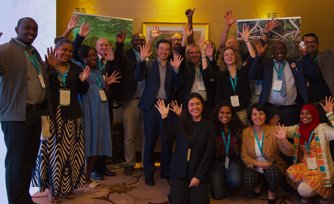
ABU DHABI, 12 DEC 2024
On 12 December 2024, the International Mangrove Conservation and Restoration Conference in Abu Dhabi hosted a landmark workshop titled "Harnessing Blue Carbon: Integrating Mangrove Restoration and Community Engagement." Organised by the United Nations Environment Programme, the event brought together experts, policymakers, and community leaders to explore how blue carbon initiatives can be scaled up ethically and sustainably.
But amidst the technical discussions and policy insights, one moment stood out -a moment that laid bare the emotional and ethical challenges of the blue carbon market.
The Moment That Shook the Room
During a heated debate on carbon credit pricing, a participant was brought to tears. His voice broke as he described how blue carbon projects in developing countries are being unfairly undervalued, with prices per tonne of carbon sequestration often far lower than those in wealthier nations.
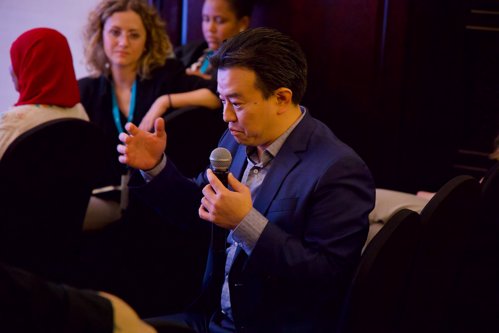
Brian Tsuyoshi Takeda, Co-Founder of Restorae and Founder of Urchinomics
"It’s heartbreaking. We see projects in the Global North getting $200, even $500 per tonne, while high-integrity projects in Kenya, Benin, and Indonesia are struggling to sell credits at $20.
Are we saying that the work we do the same work is worth less just because it happens in a developing country?" said Brian Tsuyoshi Takeda, Co-Founder of Restorae and Founder of Urchinomics
This "developing country discount" struck a nerve, highlighting an ongoing imbalance in the voluntary carbon market.
The frustration echoed throughout the room. It wasn’t just about numbers - it was about fairness, equity, and the sustainability of projects that provide both climate solutions and livelihoods.
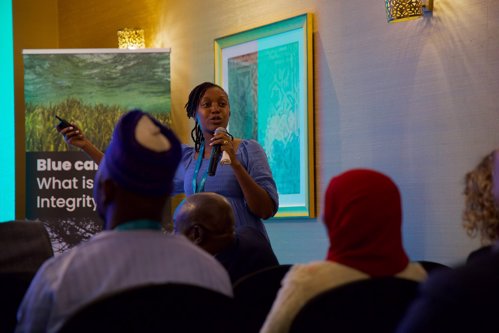
Lilian Muhaki Moggi, PhD researcher at Edinburgh Napier University
Bridging the Knowledge Gap in Blue Carbon Markets
The Abu Dhabi Mangrove Conference and UNEP’s Communities and Blue Carbon Workshop provided crucial platforms to highlight how projects are designed, financed, and monitored. A key takeaway was the urgent need to increase transparency and ensure that blue carbon markets benefit communities on the ground.
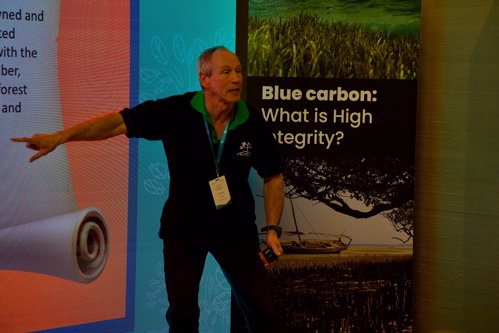
Prof. Mark Huxham - ACES
"We have some of the best examples of community-led carbon projects in the world, yet they are undervalued. The people restoring mangroves should be paid fairly for their efforts. It is time for the market to reflect that reality."
Said a member of the audience during a Q&A session after a presentation by Dr Mark Huxham, who has worked extensively on Kenya’s Mikoko Pamoja and Vanga Blue Forest projects.
The discussions focused on:
- Project design: How to maximise both environmental and social benefits.
- Market integrity: Ensuring blue carbon projects mitigate climate change while delivering tangible benefits to local communities.
- The price gap: Unpacking why high-integrity carbon offsets from Kenya are receiving a fraction of the price per tonne compared to projects in Europe or Japan.
The Pricing Debate: A Potentially Unequal System
A significant point of concern was why blue carbon credits from the Global South receive lower prices than those from the Global North Kenyan projects, for example, are delivering high-integrity offsets yet selling at a fraction of the price of European projects.
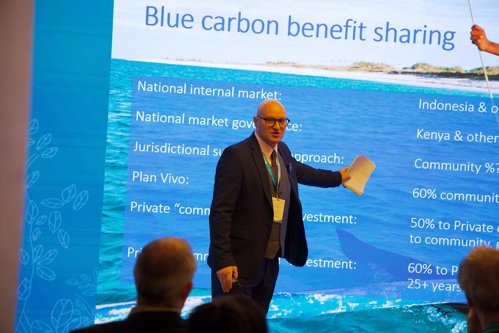
Steven Lutz, Blue Carbon Lead of GRID-Arendal
"Why do we see voluntary carbon markets treating carbon like a commodity but then pricing it based on geography? If we truly value climate action, a tonne of carbon sequestered in Kenya should be worth the same as a tonne in Norway." Said Steven Lutz, Blue Carbon Lead of GRID-Arendal.
Many participants expressed concern that the current carbon market structure perpetuates global inequality, disadvantaging some vulnerable communities.
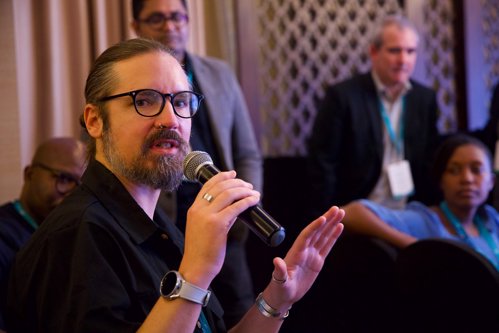
Mark Beeston - Technical Director, Blue Carbon Ecosystems, Conservation International
"The problem is not that we don’t have demand,". It’s that buyers are deliberately shopping for the lowest price rather than paying for the highest integrity. The result? High-quality blue carbon projects in developing countries are undervalued and underfunded." said a project developer from West Africa
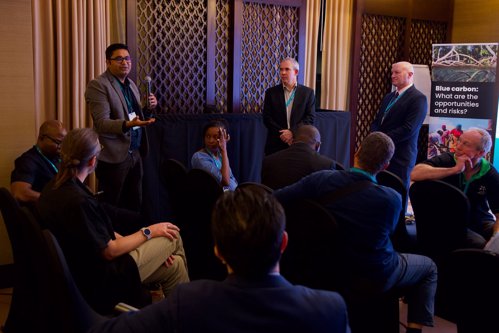
Discussions continued long after the presentations finished
If left unaddressed, this could mean that coastal communities restoring mangroves in Kenya, Benin, or Indonesia struggle to finance their conservation efforts sustainably, even though they are actively removing carbon from the atmosphere and protecting biodiversity.
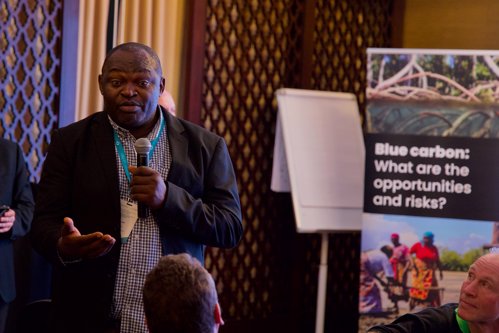
James Kairo - Principal Scientist at Kenya Marine and Fisheries Research Institute (KMFRI)
A Market Lacking Transparency
Another key challenge raised was transparency in the blue carbon market. Many projects claim to be high quality and high integrity, but in reality, there is no easy way to compare them.
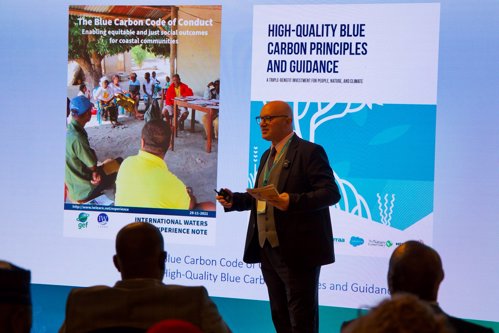
Steven Lutz, Blue Carbon Lead of GRID-Arendal
"There’s a real problem here, every carbon credit on the market claims to be ‘high integrity,’ but the truth is that some are delivering far more benefits than others. Without transparency, buyers can’t differentiate between a genuinely impactful project and one that is just ticking the minimum requirements," Said Steven Lutz, Blue Carbon Lead of GRID-Arendal.
To ensure credibility and fairness, experts at the workshop called for:
- Greater transparency on benefit-sharing and financial flows.
- There is a more precise differentiation between different types of blue carbon credits.
- More robust verification standards to prevent lower-quality credits from diluting the market.
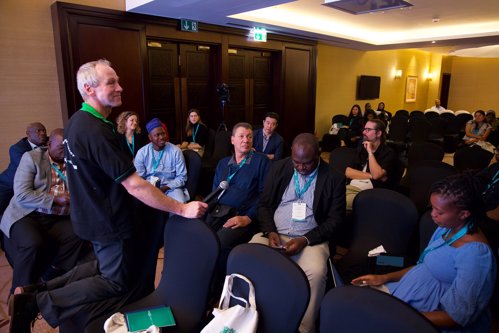
The workshop ended, but the discussions continued
The workshop ended, but the discussions it sparked are far from over. As participants gathered their notes and packed away their laptops, the energy in the room remained charged with a shared sense of urgency.
A scientist from an East African project stood near the exit, deep in conversation with a policymaker from a global NGO. Nearby, a project developer from Southeast Asia was exchanging contact details with a potential investor. Conversations weren’t winding down, they were accelerating because the people in that room knew this was just the beginning.
“Blue carbon is not just about numbers, it’s about justice.”
A simple yet powerful truth emerged from the discussions
A tonne of carbon stored in the Global South should be worth the same as one stored in the Global North.
Communities restoring mangroves should receive the financial rewards they deserve.
Market transparency is not a luxury - it’s a necessity.
Now, the challenge is to take these discussions beyond the conference walls.
What’s Next?
The insights from this workshop will contribute directly to UNEP’s forthcoming Blue Carbon report</a >, which aims to provide practical guidance for governments, communities, and investors in developing high-integrity blue carbon projects. Moving forward, translating these discussions into actionable policy and market frameworks will be essential in ensuring that blue carbon initiatives not only contribute to global climate goals but also support sustainable and just economic and social development in coastal communities.
For those looking to explore more about blue carbon, transparency in carbon markets, and the latest research, check out these resources:
GRID-Arendal’s Blue Carbon Initiatives – https://www.grida.no/bluecarbon</a >
UNEP’s Blue Carbon Report & Resources
Seagrass: https://www.unep.org/resources/report/out-blue-value-seagrasses-environment-and-people</a >
Kelp: https://www.unep.org/resources/report/blue-securing-sustainable-future-kelp-forests</a >
Coral reefs: https://www.unep.org/resources/status-coral-reefs-world-2020</a >
The future of blue carbon isn’t just about science and policy - it’s about people. The ones restoring mangroves, fighting for fair compensation, and demanding a better system.
This is their story and it’s time the world listened.
More to Read


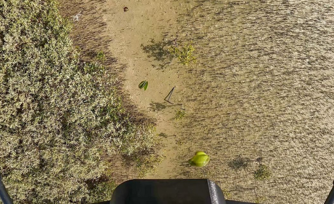
ABU DHABI, 16 OCT 2023
Drones Are Helping Plant 100 Million Mangrove Trees in the UAE by 2030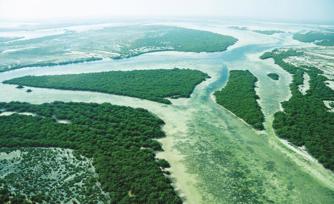
ABU DHABI, 15 MAR 2024
Mangroves: Important Nature-Based Solution That Helps Combat Climate Change